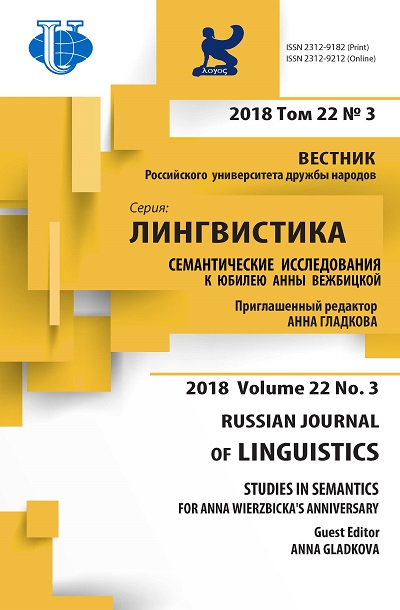A Corpus Investigation of English Cognition Verbs and their Effect on the Incipient Epistemization of Physical Activity Verbs
- Authors: Rice S.1, Newman J.1,2
-
Affiliations:
- University of Alberta
- Monash University
- Issue: Vol 22, No 3 (2018): Studies in semantics: for Anna Wierzbicka’s anniversary
- Pages: 560-580
- Section: STUDIES IN SEMANTICS: For Anna Wierzbicka’s anniversary
- URL: https://journals.rudn.ru/linguistics/article/view/19347
- DOI: https://doi.org/10.22363/2312-9182-2018-22-3-560-580
- ID: 19347
Cite item
Full Text
Abstract
About the authors
Sally Rice
University of Alberta
Email: sally.rice@ualberta.ca
Professor in the Department of Linguistics at the University of Alberta. Her research spans multiple sub-disciplines, including lexical semantics, comparative Athapaskan, corpus linguistics, cognitive linguistics, and multimodality in language. She conducts fieldwork on Dene Sųłiné and Tsuut’ina, two northern Athapaskan languages, and has been an active proponent and practitioner of community-university research alliances - community-based corpus-building in particular. She was a co-founder of the Canadian Indigenous Languages and Literacy Development Institute (CILLDI), an annual summer school for speakers of indigenous languages, which trains community language activists in linguistic analysis, language pedagogy, and revitalization project development and advocacy. 116 St. and 85 Ave., Edmonton, AB, Canada T6G 2R3
John Newman
University of Alberta; Monash University
Email: john.newman@ualberta.ca
Professor Emeritus in the Department of Linguistics at the University of Alberta and an Adjunct Research Fellow in the School of Languages, Literatures, Cultures and Linguistics at Monash University. His research focus has been mainly in areas of cognitive linguistics, especially cognitive linguistic approaches to basic verbs. His research interests also include corpus linguistics, quantitative methods in linguistics, and historical linguistics. He has published research on Germanic, Sinitic, Austronesian, and Papuan languages. He is currently the Outgoing Editor-in-Chief of the journal “Cognitive Linguistics”. 116 St. and 85 Ave., Edmonton, AB, Canada T6G 2R3
References
- Agresti, A. (2007). An Introduction to Categorical Data Analysis, 2nd edition. Hoboken, NJ: John Wiley and Sons.
- Aijmer, K. (1997). I think - an English modal particle. In Swan, T & O. J. Westwik (eds.) Modality in Germanic Languages: Historical and Comparative Perspectives. Berlin/New York: Mouton de Gruyter, 1-47.
- Bybee, J. (2010). Language, Usage, and Cognition. Cambridge: Cambridge University Press.
- Dancygier, B. (2017a). Introduction. In Dancygier, B. (ed.) The Cambridge Handbook of Cognitive Linguistics. Cambridge: Cambridge University Press, 1-10.
- Dancygier, B. (ed.). (2017b). The Cambridge Handbook of Cognitive Linguistics. Cambridge: Cambridge University Press.
- Davies, M. (2008). The Corpus of Contemporary American English: 450 million words, 1990-present. http://corpus.byu.edu/coca/.
- Goddard, C. (1997). Semantic Analysis: A Practical Introduction. Oxford: Oxford University Press.
- Goddard, C. & A. Wierzbicka. (2014). Words and Meanings: Lexical Semantics Across Domains, Languages, and Cultures. Oxford: Oxford University Press.
- Gries, S. Th. (2013a). Statistics for Linguistics with R. A Practical Introduction. Berlin: De Gruyter.
- Gries, S. Th. (2013b). Basic significance testing. In Podesva, R. J. & D. Sharma (eds.) Research Methods in Linguistics. Cambridge: Cambridge University Press, 316-336.
- Hale, K. L. (1972). A new perspective on American Indian linguistics. In Ortiz, A. (ed) New Perspectives on the Pueblos. Albuquerque: University of New Mexico Press, 87-103.
- Kärkkäinen, E. (2003). Epistemic Stance in English Conversation: A Description of its Interactional Functions, with a Focus on I think. Amsterdam/Philadelphia: John Benjamins.
- Knowles, G. & Z. M. Don. (2004). The notion of a “lemma”. Headwords, roots and lexical sets. International Journal of Corpus Linguistics 9, 69-81.
- Langacker, R. W. (1991). Concept, Image, and Symbol: The Cognitive Basis of Grammar. Berlin/ New York: Mouton de Gruyter.
- Newman, J. & S. Rice. (2006). Transitivity schemas of English EAT and DRINK in the BNC. In Gries, S. Th. & A. Stefanowitsch (eds.) Corpora in Cognitive Linguistics: Corpus-based Approaches to Syntax and Lexis. Berlin/New York: Mouton de Gruyter, 225-260.
- R Development Core Team. (2018). R. A Language and Environment for Statistical Computing. Vienna, Austria.
- Scheibman, J. (2001). Local patterns of subjectivity in person and verb type in American English conversation. In Bybee, J. & P. Hopper (eds.) Frequency and the Emergence of Linguistic Structure. Amsterdam & Philadelphia: John Benjamins, 61-89.
- Scheibman, J. (2002). Point of View and Grammar: Structural Patterns of Subjectivity in American English Conversation. Amsterdam/Philadelphia: John Benjamins.
- Schoonjanns, S. (2012). The particulization of German complement-taking mental predicates. Journal of Pragmatics 44, 776-797.
- Silverstein, M. (1976). Hierarchy of features and ergativity. In Dixon, R. M. W. (ed.) Grammatical Categories in Australian Languages. Canberra: Australian Institute of Aboriginal Studies, 112-171.
- Sinclair, J. (1991). Corpus, Concordance, Collocation. Oxford: Oxford University Press. Spivey, M. (2008). The Continuity of Mind. Oxford: Oxford University Press.
- Tao, H. (2001). Discovering the usual with corpora: The case of remember. In Simpson, R. & J. Swales (eds.) Corpus Linguistics in North America: Selections from the 1999 Symposium. Ann Arbor: University of Michigan Press, 116-114.
- Tao, H. (2003). A usage-based approach to argument structure: Remember and forget in spoken English. International Journal of Corpus Linguistics 8 (1), 75-85.
- Thompson, S. A. & A. Mulac. (1991). A quantitative perspective on the grammaticization of epistemic parentheticals in English. In Traugott, E. C. & B. Heine (eds.) Approaches to Grammaticalization, Volume II: Focus on Types of Grammatical Markers. Amsterdam/Philadelphia: John Benjamins, 313-329.
- Van Bogaert, J. (2011). I think and other complement-taking mental predicates: A case of and for constructional grammaticalization. Linguistics 49 (2), 295-332.
- Wierzbicka, A. (1996). Semantics, Primes, and Universals. Oxford: Oxford University Press. Wierzbicka, A. (2006). English: Meaning and Culture. Oxford: Oxford University Press.
- Wierzbicka, A. (2010). Experience, Evidence, and Sense: The Hidden Cultural Legacy of English. Oxford: Oxford University Press.
Supplementary files















